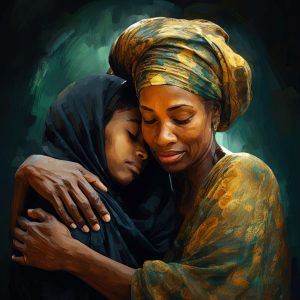2 Black Feminist Rhetoric on Motherhood

Motherhood has been a significant theme in Black feminist scholarship since the publication of Anna Julia Cooper’s seminal text A Voice From the South in 1892. Cooper advocated for the visibility of Black women as America continued to recover during the post-Reconstruction era. Specifically, she drew attention to Black women as foundational to “the re-training of the race, as well as the groundwork and starting point of its progress upward” through the sanctity of the Black family.[1] In particular, she held mothers in high regard, positioning them as most capable to ensure the safety and peace that many Black families could not experience outside of the home. This stance celebrates Black womanhood and reframes Black mothers as essential to racial progression and sustainability“This stance celebrates Black womanhood and reframes Black mothers as essential to racial progression and sustainability.”: “The atmosphere of homes is no rarer and purer and sweeter than are the mothers in those homes. A race is but a total of families.”[2] Cooper’s book recalls Frances Ellen Watkins Harper’s speech “We Are All Bound Together” (1866) in its attention to the social and political obstacles placed at the feet of Black mothers simply seeking to survive and to care for their families. However, Cooper refrained from soliciting assistance from white suffragists and celebrated Black women’s ability to stand on their own. As such, A Voice From the South birthed a canon of Black feminist rhetoric that continued to defend Black motherhood throughout the twentieth century.
Over the next few decades, women’s suffrage and anti-lynching advocate Ida B. Wells penned several speeches and essays, including “Lynch Law in America” (1930), that criticized the United States for its refusal to acknowledge the impact of lynching on the Black family, in general, and the Black mother, specifically. When men who were fathers and sons were murdered, their wives and mothers were left behind to keep their families intact and to protect their remaining children from suffering the same fate. Like Cooper, Wells highlighted lingering philosophical beliefs from slavery, but she connected them to external factors that made it difficult to achieve Cooper’s desire for Black women. Angelina Grimké’s play Rachel (1916) exemplifies the responsibility thrust upon Black mothers in the lynching era. The play encompasses the loss experienced by Black families, the fears held by Black mothers who were powerless to protect their children from racism, and the aim to encourage social mobility through formal education.
The Black feminist agenda of the 1960s and 1970s expanded the call to action for Black women and encouraged an introspective confrontation of the communities and homes they occupied. As replacements for the women’s clubs that were popular in previous decades, groups such as the Combahee River Collective, the National Black Feminist Organization, and Black Women Organized for Action spearheaded efforts that called Black women to active duty (YouTube). Scholars of this era also critiqued the dissipating relationship between Black men and Black women in the home and in the community. Black women writers featured in Toni Cade Bambara’s The Black Woman: An Anthology (1970) used their craft to showcase their significant concern for the political and patriarchal intolerances directed toward Black women. For example, Frances M. Beal in “Double Jeopardy: To Be Black and Female” (1970) writes,
[The black male] sees the system for what it really is for the most part, but where he rejects its values and more on many issues, when it comes to women, he seems to take his guidelines from the pages of the Ladies’ Home Journal. Certain black men are maintaining that they have been castrated by society but that black women somehow escaped this persecution and even contributed to this emasculation.[3]
Michelle Wallace’s Black Macho and the Myth of the Superwoman (1978) also highlights Black women’s frustration with the ill treatment they experienced within their own communities. In this era, novels, poems, and plays shifted to indicting white men and Black men as threats to Black women. Contrary to earlier writings that focused primarily on interracial dynamics, the concern with protecting Black men dissipated and the Black woman was empowered to expose Black men as a cause of suffering as well. Novels dominated this discourse in Black women’s literature, such that the 1960s and 1970s produced works like Maya Angelou’s I Know Why the Caged Bird Sings (1969), Toni Morrison’s The Bluest Eye (1970) and Song of Solomon (1977), and Gayl Jones’ Corregidora (1975). Notably, these texts center the “girl child” without paying full attention to the mother figure and her influence on or over her daughter.

Black feminist contributions of the 1960s and 1970s also articulated the idea that gender, race, and class formed a nexus of equally important factors in Black women’s writings. Barbara Smith, Deborah McDowell, Valerie Smith, and Gloria Hull, for instance, confronted the skewed assessments of Black female identity that continued to render the Black woman invisible and abandoned. In “Barriers to Connecting: Black Sexual Politics in Aishah Rahman’s The Lady and the Tramp,” Ama Wattley contends that literature written during the Black Arts Movement reflected a misogynistic attitude resulting from “created distrust and hostility between black men and black women.”[4] Critics such as Samuel A. Hay in African American Theatre: An Historical and Critical Analysis (1994) accuse playwright Ntozake Shange, in particular, of constructing a “tragic picture of the black man gone from insensitive and irresponsible to mad [that] was unlike any that had ever been seen in African American theatre.”[5] As Olga Barrios notes in her 2003 essay “From Seeking One’s Voice to Uttering the Scream: The Pioneering Journey of African American Women Playwrights through the 1960s and 1970s,” playwrights of the era were propelled “to find their own voices within their communities, adding a gender perspective that widened and completed the delineation established by male theater artists” who tended to ignore issues important to Black women.[6]
Between the 1980s and the early 2000s, drama and literary critics such as Kathy A. Perkins, Judith L. Stephens, Trudier Harris, Margaret Wilkerson, Sydné Mahone, Joyce A. Meier, and Lisa M. Anderson illustrated Black feminist rhetoric as informative to many of the subjects confronted by Black female playwrights—Black mothers, in particular. Nonetheless, it was Patricia Hill Collins’s theory on Black feminist thought that gathered key contributions from past periods to broaden the scope of Black feminist rhetoric on womanhood. According to Hill Collins’s essay “Learning from the Outsider Within: The Sociological Significance of Black Feminist Thought” (1986), Black women develop “a special standpoint on self, family, and society” that allows them to reside within a racially oppressive environment without succumbing to its stereotypical ideals concerning Black womanhood.[7] The intersection of race, gender, and class yields a point of view that differs significantly from the ones put forth by whites and Black males. To support her theory on existing Black female standpoints, Hill Collins turned to the ample evidence generated through Black feminist criticism put forth by scholars of her time: “Taken together, the three key themes in Black feminist thought—the meaning of self-definition and self-valuation, the interlocking nature of oppression, and the importance of redefining culture— have made significant contributions to the task of clarifying a Black women’s standpoint of and for Black women.”[8] The Black woman described by Hill Collins, real or fictional, is empowered by her ability to recognize her worth and the worth of other Black women, particularly when facing adversity.
Also, Hill Collins’s text Black Feminist Thought: Knowledge, Consciousness, and the Politics of Empowerment (2000) provides a framework for four stereotypical embodiments of Black women that have become archetypal portrayals: the Mammy, the Matriarch, the Welfare Mother, and the Jezebel. “These motherhood tropes—particularly the Matriarch, the Welfare Mother, and the Jezebel—deviate from the race-building and family-saving mother image put forth in previous decades.”The Mammy is seen as an asexual caretaker or maid who works diligently for her white patron as a surrogate maternal figure. The Matriarch (or the Sapphire) is the domineering mother who prides herself on hyper-independence. She drives her children and partners away due to her aggressive speech and actions. The Welfare Mother is a lazy mother who does not want to work and strives to collect aid from government assistance and from men. Finally, the Jezebel archetype is a salacious and concupiscent woman who prides herself in exploring her sexual desires, often to the detriment of her children. These motherhood tropes—particularly the Matriarch, the Welfare Mother, and the Jezebel—deviate from the race-building and family-saving mother image put forth in previous decades.
Hill Collins’s interrogation of these stereotypical maternal figures laid the groundwork for a contemporary Black female Motherhood Aesthetic that steps away from a viewpoint in which the Black mother is a valiant figure and grapples with societal and cultural vices that lead to successes and failures alike.
- Anna Julia Cooper, A Voice From the South (Aldine Printing House, 1892), Documenting the American South, University of North Carolina at Chapel Hill, http://www.docsouth.unc.edu/church/cooper/cooper.html, 28. ↵
- Cooper, A Voice, 29. ↵
- Frances M. Beal, “Double Jeopardy: To Be Black and Female,” in The Black Woman: An Anthology, ed. Toni Cade Bambara (1970; repr., Washington Square Press, 2010), 170. ↵
- Ama Wattley, “Barriers to Connecting: Black Sexual Politics in Aishah Rahman’s The Lady and the Tramp,” Obsidian III: Literature in the African Diaspora 1, no. 1 (1999): 141. ↵
- Samuel A. Hay, African American Theatre: An Historical and Critical Analysis (Cambridge University Press, 1994), 96. ↵
- Olga Barrios, “From Seeking One’s Voice to Uttering the Scream: The Pioneering Journey of African American Women Playwrights through the 1960s and 1970s,” African American Review 37, no. 4 (2003): 611–28. ↵
- Patricia Hill Collins, “Learning from the Outsider Within: The Sociological Significance of Black Feminist Thought,” Social Problems 33, no. 6 (1986): 514–32. ↵
- Hill Collins, “Learning,” 524. ↵



